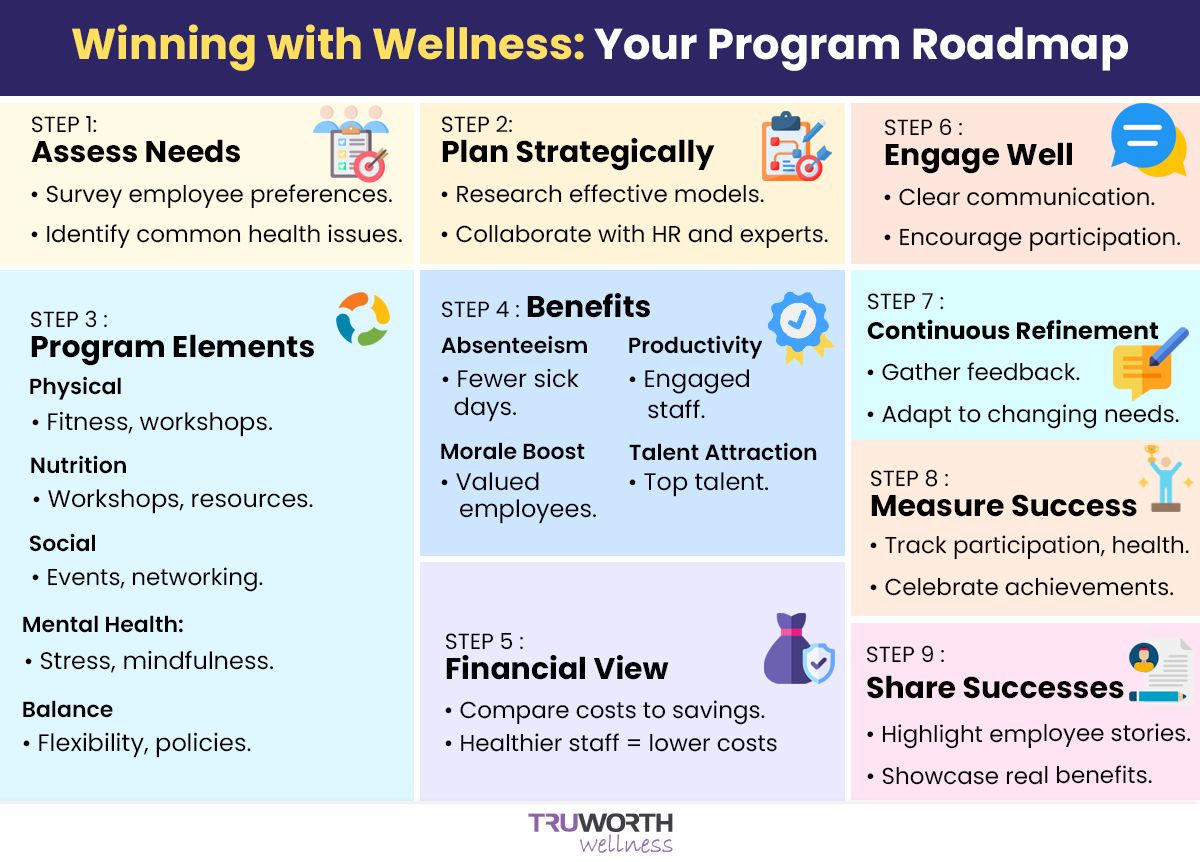Steps To Convince Your Management To Implement A Wellness Program

Convincing your management to implement a corporate wellness program requires a well-structured and persuasive approach.
Here's a step-by-step guide to help you make your case effectively:

1. Understanding the Need
- Are stress levels rising?
- Do employees feel overwhelmed?
- Is absenteeism becoming more frequent?
Before making your case, it's crucial to understand the specific challenges your organization faces. High-stress levels, employee burnout, absenteeism, and rising healthcare costs can impact your company's productivity and bottom line. For instance, studies show that stress costs businesses around $300 billion annually in lost productivity.
2. Research and Data: The Power of Evidence
- Are there statistics showing wellness programs make a difference?
- Can they reduce sick days and boost happiness?
- Are there stories that highlight the positive impact?
Presenting a solid case backed by data can be a game-changer. Gather statistics and research studies that highlight the transformative effects of corporate wellness programs. For instance, companies with wellness programs report a 28% reduction in sick leave and a 26% reduction in healthcare costs.
3. Making It Fit Your Company
- Can the program match your company's values?
- Can it tackle specific issues unique to your company?
Your company is unique, so the wellness program should be too. Showcase how a wellness program resonates with your company's core values and long-term vision. Address the specific challenges your organization is grappling with, and demonstrate how the program's offerings can be tailored to provide targeted solutions.
Must Check: Is Your Company's Stress Management Program Stressful in Itself?
4. Financial Benefits: Investing Wisely
- Do healthy employees visit the doctor less?
- Does increased productivity mean lower costs?
- Can you explain the long-term financial benefits?
One of the most persuasive arguments for a wellness program is its potential ROI. Highlight that healthier employees tend to have lower healthcare costs and are more productive. A wellness program can lead to reduced turnover, saving the company recruitment and training expenses. Research indicates that for every $1 spent on employee wellness, companies can save $3 in healthcare costs.
5. Employee Engagement and Retention: Nurturing Your Workforce
- Can wellness programs boost employee satisfaction?
- Do happier employees tend to stick around?
- Can you mention the cost-effectiveness of retaining employees?
Employee engagement and retention are cornerstones of a successful organization. Highlight how a comprehensive wellness program can significantly impact these areas. Happier and healthier employees are more likely to be engaged in their work and loyal to the company. A wellness program sends a clear message that the company cares about its employees' well-being, fostering a sense of loyalty and commitment.
6. Performance Enhancement: Energizing the Workforce
- Can you share real examples of improved team performance?
- Do employees who feel good tend to do better work?
- Can you highlight how wellness leads to creativity and innovation?
Enthusiastic and motivated employees are crucial for sustained success. By prioritizing their well-being, you're directly impacting their energy levels, focus, and overall performance. Share examples of companies that have reaped the rewards of wellness initiatives, with employees reporting increased creativity, innovation, and an overall boost in productivity.
7. Gaining a Competitive Edge: Attracting Top Talent
- In a competitive job market, does a wellness program stand out?
- Can you attract top talent with unique offerings?
- Can you explain the program's appeal to potential hires?
In today's competitive job market, attracting and retaining top talent is a formidable challenge. A well-structured wellness program sets your organization apart from the competition. Prospective employees view wellness offerings as an attractive benefit, leading to increased interest in your company and potentially reducing recruitment efforts.
8. Detailed Program Outline: A Blueprint for Success
- Can you offer a variety of activities: fitness classes, workshops, etc.?
- Can you define goals and ways to measure success?
- Can you illustrate the practical aspects of the program?
A well-structured wellness program requires meticulous planning. Outline the program's components, including fitness classes, mindfulness workshops, nutritional guidance, stress management sessions, and more. Define the program's goals, establish a timeline, and explain how the success of the program will be measured using key performance indicators (KPIs).
9. Cost Analysis: Balancing Investment and Return
- Can you address concerns about the investment?
- Can you show how wellness pays off in the long run?
- Can you discuss the return on investment through health and productivity?
Address management's concerns about costs by providing a comprehensive financial analysis. While there is an initial investment required, stress how the long-term benefits—such as reduced healthcare costs and increased productivity—far outweigh the initial expenses. Illustrate potential savings through data and projections.
10. Employee Testimonials: The Voice of Experience
- Can you gather testimonials from supportive employees?
- Can you explain how real stories add credibility and relatability?
- Can you show how employee voices back up your proposal?
Bring in the voices of your fellow employees who support the wellness program. Their stories can lend credibility to your proposal and demonstrate that there's genuine interest and enthusiasm among the workforce.

11. Putting the Plan in Action
- Can you present a clear, step-by-step plan?
- Can you suggest starting with a pilot program?
- Can you show the practical path to implementing the program?
Present a detailed plan for the wellness program, including types of activities (fitness classes, mental health workshops, nutritional guidance, etc.), frequency, and expected outcomes. Address any potential concerns or challenges that management might raise.
12. Listening to Concerns
- Can you approach management with an open mind?
- Can you address any worries or doubts they have?
- Can you be ready to provide additional information?
When presenting your proposal, maintain an open dialogue. Be prepared to answer questions, address concerns, and provide additional information if needed. Encourage an open dialogue to address any reservations they might have.
13. Painting a Bright Future
- Can you help management visualize success?
- Can you describe a positive and thriving work environment?
- Can you connect the program to an improved company culture?
Paint a picture of what success could look like with a thriving wellness program. Envision healthier, happier, and more engaged employees who contribute to positive company culture and improved performance.
Conclusion: A Brighter Future for Everyone
A corporate wellness program isn't just a nice thing to have; it's a smart move for any company. By showcasing the benefits through research, data, and tailored proposals, you can persuade your management to prioritize employee well-being.
Remember, a healthier workforce isn't just good for individuals; it's a strategic advantage that can significantly impact your company's success in the long run. Embrace the journey toward unlocking your employees' full potential through a well-designed and thoughtfully implemented corporate wellness program.